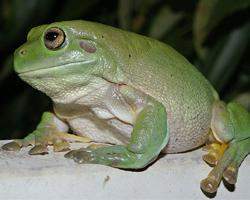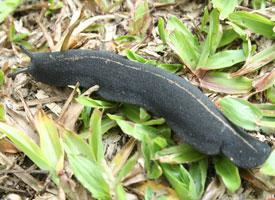
Súlyok és méretek
| Hossz | 6-tól 11-ig cm |
|---|
Veszélyeztetettség
| Veszélyeztetett |
Állatleírás
The Australian green tree frog, scientifically known as Litoria caerulea, is a captivating species that is not only admired for its vibrant coloration but also for its fascinating biology and behavior. This species is indigenous to Australia and New Guinea, thriving in a variety of habitats ranging from the lush, tropical rainforests to the cooler climates of the southern regions. Its adaptability to different environments, including those altered by humans, has made it a common sight in gardens and houses, where it is often welcomed for its insect control abilities.Physical Characteristics:
The Australian green tree frog is a robust and sizable amphibian, with adults typically reaching lengths of up to 10 centimeters (4 inches). It possesses a striking bright green coloration that can vary in hue from a vivid leaf-green to a more subdued olive, allowing it to blend seamlessly into its arboreal surroundings. This camouflage is vital for evading predators and hunting prey. Some individuals may display small, white or gold spots, and the intensity of their color can change depending on their environment and health. The underbelly of the frog is creamy-white, providing a stark contrast to its vibrant dorsum. Its large, protruding eyes are another distinctive feature, equipped with horizontal, slit-shaped pupils that enhance its nocturnal vision. The toes of the Australian green tree frog are fully webbed, with large suction cup-like pads at the tips, enabling it to climb and cling to various surfaces with remarkable agility.
Behavior and Diet:
Primarily nocturnal, the Australian green tree frog embarks on its activities under the cover of night. Its diet mainly consists of insects and spiders, but it is known to consume larger prey, such as small mammals and other frogs, on occasion. The hunting strategy of Litoria caerulea is one of patience and precision, waiting motionlessly for unsuspecting prey to venture within reach before striking with its sticky, projectile tongue.
Reproduction and Lifecycle:
The breeding season for the Australian green tree frog typically occurs during the warmer, wetter months, when males call to attract females from the safety of water bodies. The female lays hundreds to thousands of eggs in still or slow-moving waters, which then hatch into tadpoles. These tadpoles undergo a metamorphosis over several months, transforming into juvenile frogs that are fully terrestrial. This species is noted for its relatively long lifespan among frogs, with individuals living up to 15 years in the wild and even longer in captivity under optimal conditions.
Conservation Status:
Currently, the Australian green tree frog is classified as of "Least Concern" by the International Union for Conservation of Nature (IUCN), owing to its wide distribution and large, stable population. However, like many amphibians, it faces threats from habitat destruction, pollution, climate change, and diseases such as the chytrid fungus. Conservation efforts are essential to ensure the continued survival of this species, emphasizing the importance of protecting its natural habitats and addressing global environmental challenges.
In conclusion, the Australian green tree frog is a remarkable amphibian with a distinctive appearance and intriguing behaviors that have endeared it to both scientists and the general public. Its ability to adapt to various environments, coupled with its role in controlling insect populations, underscores its importance in the ecosystem and highlights the need for continued conservation efforts to protect this and other amphibian species for future generations.
Előfordulási térkép

Új állatfotók
Top 10 állat
- Dolphin gull (Leucophaeus scoresbii)
- Japanese macaque (Macaca fuscata)
- Stone loach (Barbatula barbatula)
- Russian tortoise (Testudo horsfieldii)
- Galápagos tortoise (Geochelone nigra complex)
- Greek tortoise (Testudo graeca)
- Diana monkey (Cercopithecus diana)
- Common flying dragon (Draco volans)
- Moustached guenon (Cercopithecus cephus)
- Galápagos penguin (Spheniscus mendiculus)


